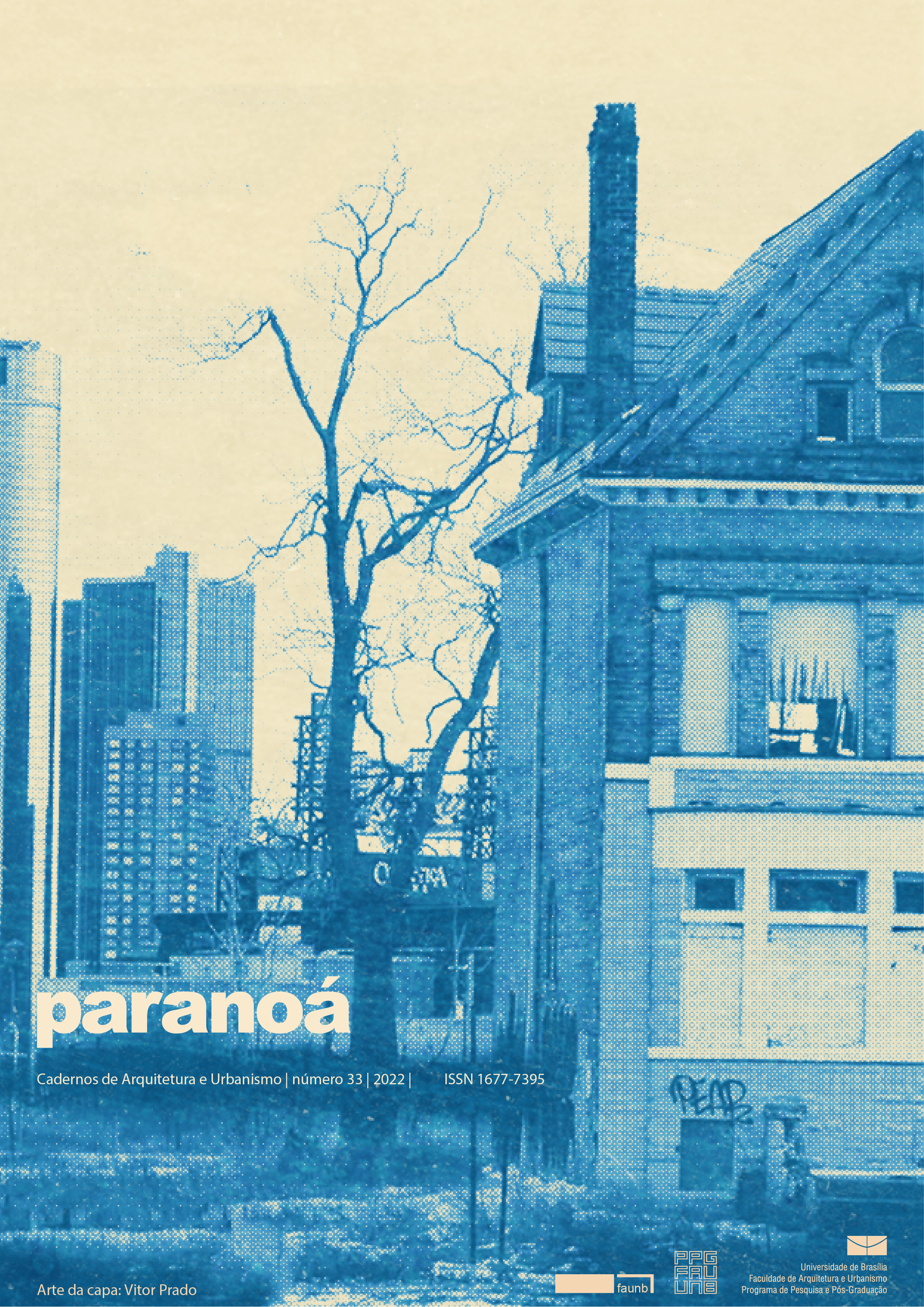From the fortress to the remains of the city: a brief incursion on the subject in the field of Art
DOI:
https://doi.org/10.18830/issn.1679-0944.n33.2022.22Keywords:
Fortaleza, Urban Narrative, Remains, Image of the City, ArtAbstract
This article aims to discuss how the city can be read through its obsolete spaces. Taking as a starting point the representative case of Fortaleza, a tourist center published in the media with its buildings with smooth and shiny facades on the waterfront, we resort to its counter-image, the degraded and forgotten parts of the great urban narrative. Fortaleza, then, as a fortress of buildings that rises against the city and the remains as gaps that resist to stay in the landscape. The study proceeds with a brief incursion into artistic practices that elucidate issues related to the theme of remains and what they can tell us, to broaden the debate about the specific focus of Fortaleza. Based on the analysis of the paradigmatic work of Gordon Matta-Clark and of more recent works by Ximena Garrido-Lecca and Lara Almarcegui, it is understood that the questions raised in the field of Art are fundamental for the resumption of the category of remains in the debate on the ongoing processes in large metropolises. Thus, from the study of the gaps in the wall-fortress cities, new fields of reflection necessary for the proposition are raised.
Downloads
References
ALMARCEGUI, Lara. Guia de Terrenos Baldios de São Paulo: uma seleção dos lugares vazios mais interessantes. São Paulo: Fundação Bienal de São Paulo, 2006.
ARANTES, Otília; MARICATO, Ermínia; VAINER, Carlos. A cidade do pensamento único: desmanchando consensos. 8ª ed. Petrópolis: Vozes, 2013. 192 p.
ASSOCIAÇÃO CULTURAL VIDEOBRASIL. Catálogo da 21ª Bienal de Arte Contemporânea Sesc_Videobrasil. São Paulo: Edições SESC, 2019.
BELMINO, Sílvia. Sinta na pele esta magia: a propaganda turística do Ceará (1987-1994). Fortaleza: Imprensa Universitária UFC, 2018. 261 p.
BUENAVENTURA, Julia. Propriedades sem bens: dos lotes de Gordon Matta-Clark às manifestações de Félix González-Torres. 2014. Tese (Doutorado em Arquitetura e Urbanismo) - Universidade de São Paulo.
CALVINO, Italo. As cidades invisíveis. São Paulo: Companhia das letras, 1990. 150 p.
CASTELLS, Manuel. A Intervenção Administrativa nos Grandes Centros Urbanos. In: Espaço & Debates, n. 6, Revista de Estudos Regionais e Urbanos. São Paulo, Cortez, 1982.
DAVIS, Mike. Planeta favela. São Paulo: Boitempo, 2006. 272 p.
FERREIRA, Napoleão. O muro. Cidades muradas. In: 21º CONGRESSO BRASILEIRO DE ARQUITETOS. Youtube. [S. l.], 25 nov. 2019. Disponível em: https://youtu.be/LklJA7haAy0. Acesso em: 20 mar. 2022.
FREUD, Sigmund. O Mal-estar na Civilização. 1ª ed. São Paulo: Penguin Classics Companhia das Letras, 2011. 96 p.
FRIEDMAN, Thomas L. O mundo é plano: o mundo globalizado no século XXI. 3ª ed. São Paulo: Companhia das Letras, 2014. 477 p.
KOOLHAAS, Rem. Rem Koolhaas: três textos sobre a cidade. Espanha: Gustavo Gili, 2014. 111 p.
KOOLHAAS, Rem. Delirious New York: a retroactive manifesto for Manhattan. New York: Monacelli Press, 1994. 321 p.
LEE, Pamela M. Object to be destroyed: the work of Gordon Matta-Clark. Cambridge: The MIT Press, 2000. 280 p.
LEFEBVRE, Henri. A produção do espaço. Trad. Doralice Barros e Sérgio Martins (do original: La production de l'espace. 4 éd. Paris: Éditions Anthropos, 2000).
NEGRI, Antonio. “Rem Koolhaas: Junkspace e metrópole biopolítica” inRadical philosophy, n.o 154 (2009). Disponível em: http://uninomade.net/tenda/rem-koolhaas-junkspace-e-metropole-biopolitica/. Acesso em: 20 mar. 2022.
RIBEIRO, Ana Clara Torres. Homens Lentos, Opacidades e Rugosidades. Revista Redobra, Salvador, n. 9, p.58-71, 2012.
SANTOS, Milton. A natureza do Espaço: técnica e tempo, razão e emoção. 4a ed. São Paulo: EDUSP, 2006.
SMITHSON, Robert. Um passeio pelos monumentos de Passaic, Nova Jersey (1967). In: Arte & Ensaios, n. 17, PPGAV-EBA-UFRJ, 2008. p. 162-167.
SOLÀ-MORALES, Ignasi de. Terrain vague. In: SOLÀ-MORALES, Ignasi de. Territorios. Barcelona: Gustavo Gili, 2002. p. 181-193.
VÁZQUEZ, Fernando. Aproximações com a cidade [fictícia]: Gordon Matta-Clark. In: RUA, v. 25, n. 2, UNICAMP, 2019. p. 389-414. Disponível em: https://periodicos.sbu.unicamp.br/ojs/index.php/rua/issue/view/1637. Acesso em: 21 jan. 2022.
VILLAÇA, Flávio. O espaço intra-urbano no Brasil. São Paulo: Studio Nobel Editora, 1998.
Downloads
Published
How to Cite
Issue
Section
License
Copyright (c) 2022 Paranoá

This work is licensed under a Creative Commons Attribution 4.0 International License.
Autores que publicam nesta revista concordam com os seguintes termos:
- Autores mantém os direitos autorais e concedem à revista o direito de primeira publicação, com o trabalho simultaneamente licenciado sob a Licença Creative Commons Attribution que permite o compartilhamento do trabalho com reconhecimento da autoria e publicação inicial nesta revista. http://creativecommons.org/licenses/by/4.0
- Autores têm autorização para assumir contratos adicionais separadamente, para distribuição não-exclusiva da versão do trabalho publicada nesta revista (ex.: publicar em repositório institucional ou como capítulo de livro), com reconhecimento de autoria e publicação inicial nesta revista.
- Autores têm permissão e são estimulados a publicar e distribuir seu trabalho online (ex.: em repositórios institucionais ou na sua página pessoal) a qualquer ponto antes ou durante o processo editorial, já que isso pode gerar alterações produtivas, bem como aumentar o impacto e a citação do trabalho publicado (Veja O Efeito do Acesso Livre).















